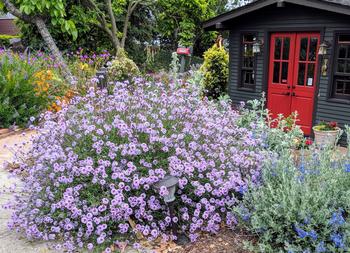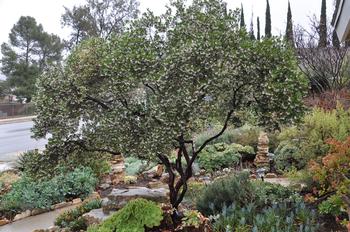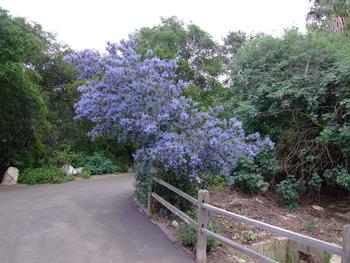Transition to native plants
-
Barbara Robertson
-
Ah, fall. The air becomes crisp. School starts. And gardeners reach for shovels, especially those who add native plants to their landscape. Taking advantage of the rainy season when native plants naturally expect water gives newbies a welcome introduction.
 The native plant Verbena lilacina ‘De La Mina’ blends well into a cottage garden. Photo: Plantmaster
The native plant Verbena lilacina ‘De La Mina’ blends well into a cottage garden. Photo: PlantmasterPlanting natives in late fall can give the plants a boost. Another successful strategy is to clear an area where the soil has not been disturbed or amended and choose plants that match the available sun in the garden spot you’ve cleared.
Many gardeners, however, want to blend native plants into an already established non-native garden rather than clear out a “native” space.
To do this, members of the Marin Master Gardeners Native Plant Guild recommend considering three things: sun and shade, existing soil, and the current irrigation system.
You can research individual plants’ sun and shade requirements using the California Native Plant Society’s website and can also find plants native to your area.
As for soil: Natives like native soil. Native plants have evolved over thousands of years to a particular environment and are not quick to make themselves comfortable elsewhere. If you have dug in compost or added fertilizers or amendments, let the soil ease back for a year. If you have soil with compost only on top, scrape it aside, place a new plant in a hole twice the width of its pot and slightly above soil level, tuck the native soil back around the plant, and re-spread the compost.
Newly planted natives will need water until the plant has grown roots down far enough to find water naturally, probably for two years. Thus, if you plant natives before the rain comes, give the new plants enough water to keep them alive and healthy. Use a water meter to check soil moisture and water only when the meter just touches “dry.” You want the plant to stretch its roots down. The Manzanita cultivar Arctostaphylos densiflora 'Howard McMinn,’ a good transition choice, sports pink blossoms in spring atop twisting red branches.
The Manzanita cultivar Arctostaphylos densiflora 'Howard McMinn,’ a good transition choice, sports pink blossoms in spring atop twisting red branches.Ideally, native plants will be in a hydrozone with plants that have similar water requirements. If not, try changing your irrigation system, especially if it is designed to deliver water to thirsty plants. Removing spaghetti lines near the new plant could work, but you’ll need to carefully watch the soil moisture level. Soil that holds too much moisture could cause root rot.
With irrigation provided by holes in the lines, it will be difficult to have the system accommodate both water-hungry non-natives and low-water natives. So instead, look on Calscape for a native that likes water, find another place for the native plant, or consider removing the non-native plants.
Rather than trying to replace non-natives with native doppelgangers, embrace a new, equally beautiful look. For example, in Tiburon, a Master Gardener replaced non-native Carex sedges with Festuca californica (California fescue) and Calamagrostis foliosa (Mendocino Reed Grass); non-native Rhododendrons with the dense evergreen shrub Frangula californica (Coffeeberry) thus trading flowers for colorful berries; and replaced non-native verbena with its cousin, the delicate, purple-flowered native Verbena lilacina ‘De La Mina.'
Native plant guild members often mention De La Mina’ Verbena. Four other popular picks include Ceanothus ‘Ray Hartman,’ Arctostaphylos densiflora 'Howard McMinn' (Manzanita), Ribes varieties, and Heteromeles arbutifolia (Toyon, California holly). Ceanothus ‘Ray Hartman,’ a cultivated hybrid, one of the easiest Ceanothus to grow, blooms in winter & spring... but deer love it. Photo: Plantmaster
Ceanothus ‘Ray Hartman,’ a cultivated hybrid, one of the easiest Ceanothus to grow, blooms in winter & spring... but deer love it. Photo: PlantmasterA San Rafael Master Gardener uses Salvias, Epilobium, Monardella (Coyote mint), and native Heuchera as accent plants. A Mill Valley gardener loves the clouds of Achillea millefolium (Yarrow) flowers in her wild, unorganized garden. The “thousand leaved” Yarrow plants have soft flower clusters in pink, red, cream, yellow, and bi-colored pastels.
Lastly, a big tip from a Novato-based Master Gardener with a mix of low-water and native plants: Native plant cultivars are easiest for home gardeners to grow. Look for plant names with English language words in single quotes like Ceanothus ‘Ray Hartman.’
For more information, please watch our short YouTube videos, “Color your Garden with CA Native Plants” and “Success with Native Plants: 4 Essential Tips”, and visit our website: https://marinmg.ucanr.edu/CARE/PLANTCARE/CANatives/.



